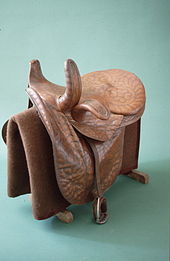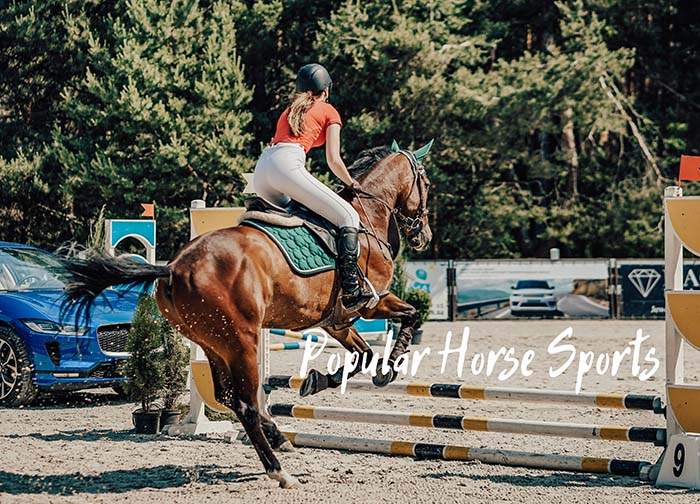Side Saddles & How to Ride a Horse Sideways

Sidesaddle riding has been around for a long time. Some say it actually looks more elegant, while others value its practicality as a technique. Whatever you may think about it, riding a horse side saddle has quite a few advantages, especially if you’re planning to ride your horse in a dress or skirt.
How do you ride a horse side-saddle? Despite what you might think, you don’t actually ride the horse sideways, but your legs are definitely in a different position when compared to riding normally. While riding aside, you need to sit very straight and square in the saddle. From the rear, it should look as if you were riding astride.
Riding side-saddle best practices.
Riders need to be very mindful of their positioning while riding sidesaddle. The spine needs to be centered on the spine of the horse. The shoulders and hips are square on the horse, while the hands must be carried square to the horse keeping both reins at the same tension and length. Obviously, I am describing an absolutely ideal and correct riding posture for the side saddle. If you want to do this type of riding recreationally, you can afford to get it wrong a bit.
The saddle has two pommels stacking up at the front. Your right leg needs to go around the top one and hang down, while the left should rest in its usual position in the stirrup. Since you sit higher than on a regular saddle, and in a different position, you will also use different muscles for balance. It’s not at all unusual to feel a bit sore a few days after riding aside for the first time.
Side saddles were not designed to be uncomfortable. If you feel uncomfortable in yours, you should probably have a closer look at fitting. It may not fit you or your horse properly.
How much does a side-saddle cost?
I should mention right off the bat that getting your hands on a good side saddle these days is difficult. That’s because they represent a very niche market – few people choose to ride their horses this way nowadays. A modern side saddle will cost quite a bit of money, with some of them going for as much as $5,000.
You can also get older, restored ones, or even antiques for as little as $900. Prices usually hover around the $1,500 mark for restored side saddles. Are they worth it? Definitely, provided you can find one that will fit you and your horse properly. Proper fitting is a real issue when it comes to side saddles, but if you can afford to get one custom-made, you should definitely go for it.
What’s the difference between a side saddle and a normal saddle?
Side saddles were designed for a different riding position when compared to astride saddles. The main difference between the two models is that the side saddle usually has two pommels, while the astride saddle will only have one. Most modern side saddles are based on the Jules Pellier two pommel design.
However, while their design might be similar, there are notable differences between different side saddles. I’m talking about the girthing system, the tree beneath, styling or fender designs. Furthermore, a sidesaddle created with a tree designed specifically for side saddle riding will offer a balanced and comfortable riding experienced. The sad news is that many modern side saddles are based on a modified astride tree. This can result in instability.
Back in the 19th century, riders would also use a single pommel sidesaddle. Up until recently, American Civil War reenactment participants would ride their horses using these saddle types. However, since they are now considered unsafe to use, they had to switch to the two-pommel type instead.
When it comes to the bridles, there are few differences between an astride saddle and a side-saddle. The reins, however, usually need to be longer on side saddles because the rider’s hands are farther away from the horse’s mouth.
The history of side saddles.

Sidesaddle riding dates back to antiquity. It was originally developed in Europe in the Middle Ages with a clear purpose – to allow women in skirts to ride horses while wearing fine clothing. The purpose was to preserve their modesty, obviously, but some would argue that riding aside also had a more dignified look, and that’s why it caught on so quickly.
When it comes to its first depictions, historians discovered images of women riding aside on Celtic stones and Greek vases. As far as the first functional sidesaddle, it was attributed to Anne of Bohemia (1366–1394). It was a relatively crude contraption more akin to a chair propped up on a horse’s back. The rider’s feet sat on a footrest. The main problem with this early design was that the woman would find it difficult to control the horse using the reins. Thus, the horse was led by a second rider sitting astride.
In the 16th century, Catherine de Medici came up with a more practical design. She had the rider sitting forward and hooking her right leg around the pommel of the saddle. The knee was secured by a horn added to the near side of the saddle. The footrest was replaced with a leather-covered stirrup iron. This new design allowed women to actually ride and control horses themselves, albeit at low speeds.
The two-pommel design that we use today was invented by Jules Pellier in the 1830s. The additional horn allowed women to ride horses at much faster speeds with improved security and control. With this saddle, they could even go fox hunting and show jumping.
Sidesaddle competitions.
Even though some regard it as an obsolete and unnecessary technique nowadays, there are still many who enjoy riding sidesaddle, and there are even competitions for it. There are two main different classes for side-saddle riding, namely English and Western classes. Obviously, the main differences between the two involve their connection to the two different riding styles. If you would like to know more about the differences between English and Western riding, have a quick look at my article right here.
Back to the matter at hand, many horse shows include judged exhibitions ( or classes) of sidesaddle riding. The judges evaluate the performance of both horse and rider based on specific styles and appointments.
In English classes, the judges base their grades on a formalized standard for an “ideal” appearance. They judge the rider’s dress, appointments, riding style, and even the type of horse that they chose to ride. Appearance-wise, riders will dress in formal attire inspired by the hunting field.
In Western classes, the rider will wear Western-style clothing, including period costumes in some cases. It’s worth noting that Western riders will add more decorations to their apparel. They will usually wear a short bolero-style jacket that matches the apron or skirt. Cowboy boots and cowboy hats are frequently worn as well.
Is it harder to ride side-saddle?
Because the rider’s leg is firmly anchored into the saddle, it’s actually much more difficult to fall off while riding side saddle when compared to riding astride. It might look a bit unusual, sure, but there’s nothing insecure about riding on a side-saddle.
If you opt to ride sideways on a regular saddle, though, that’s a completely different story. You’ll struggle for balance and you’ll likely be unable to control your horse. Always ride sideways on an actual side-saddle in order to prevent a potential accident.
Do horses require special training for side saddles?
Not at all. Most horses can be ridden with a side-saddle without receiving any extra training. It always helps if the horse has received any form of training beforehand, though. Furthermore, the horse should be calm and well-mannered.
If we’re talking about a competition horse, using a side saddle might actually prevent its early retirement. There are no requirements in terms of breeding or special talents, but there will likely be a short adjustment period until the horse gets used to its new tack.
Conclusion.
Riding a horse on a side saddle is not only incredibly elegant but also quite safe and comfortable. It might feel a bit unusual at first, but practicing it for a while will help it become second nature. Due to its unique riding position, riding this way can even help people with certain disabilities enjoy their time in the saddle more.
I have ridden aside many times and find it just as rewarding as riding astride. Once I got used to the correct leg positioning, I had no problem controlling the horse or maintaining my balance. Have you ever ridden a horse this way, and if so, how would you describe the experience?






